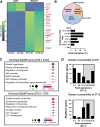Cardiac GR Mediates the Diurnal Rhythm in Ventricular Arrhythmia Susceptibility
- PMID: 38533639
- PMCID: PMC11081863
- DOI: 10.1161/CIRCRESAHA.123.323464
Cardiac GR Mediates the Diurnal Rhythm in Ventricular Arrhythmia Susceptibility
Abstract
Background: Ventricular arrhythmias (VAs) demonstrate a prominent day-night rhythm, commonly presenting in the morning. Transcriptional rhythms in cardiac ion channels accompany this phenomenon, but their role in the morning vulnerability to VAs and the underlying mechanisms are not understood. We investigated the recruitment of transcription factors that underpins transcriptional rhythms in ion channels and assessed whether this mechanism was pertinent to the heart's intrinsic diurnal susceptibility to VA.
Methods and results: Assay for transposase-accessible chromatin with sequencing performed in mouse ventricular myocyte nuclei at the beginning of the animals' inactive (ZT0) and active (ZT12) periods revealed differentially accessible chromatin sites annotating to rhythmically transcribed ion channels and distinct transcription factor binding motifs in these regions. Notably, motif enrichment for the glucocorticoid receptor (GR; transcriptional effector of corticosteroid signaling) in open chromatin profiles at ZT12 was observed, in line with the well-recognized ZT12 peak in circulating corticosteroids. Molecular, electrophysiological, and in silico biophysically-detailed modeling approaches demonstrated GR-mediated transcriptional control of ion channels (including Scn5a underlying the cardiac Na+ current, Kcnh2 underlying the rapid delayed rectifier K+ current, and Gja1 responsible for electrical coupling) and their contribution to the day-night rhythm in the vulnerability to VA. Strikingly, both pharmacological block of GR and cardiomyocyte-specific genetic knockout of GR blunted or abolished ion channel expression rhythms and abolished the ZT12 susceptibility to pacing-induced VA in isolated hearts.
Conclusions: Our study registers a day-night rhythm in chromatin accessibility that accompanies diurnal cycles in ventricular myocytes. Our approaches directly implicate the cardiac GR in the myocyte excitability rhythm and mechanistically link the ZT12 surge in glucocorticoids to intrinsic VA propensity at this time.
Keywords: arrhythmias, cardiac; circadian rhythm; glucocorticoids; ion channels; receptors, glucocorticoid; transcription factors.
Conflict of interest statement
Figures








Comment in
-
Circadian-Regulated GR Signaling Mediates Morning Arrhythmias.Circ Res. 2024 May 10;134(10):1327-1329. doi: 10.1161/CIRCRESAHA.124.324571. Epub 2024 May 9. Circ Res. 2024. PMID: 38723035 No abstract available.
References
-
- Muller JE, Ludmer PL, Willich SN, Tofler GH, Aylmer G, Klangos I, Stone PH. Circadian variation in the frequency of sudden cardiac death. Circulation. 1987;75:131–138. doi: 10.1161/01.cir.75.1.131 - PubMed
-
- Tofler GH, Gebara OC, Mittleman MA, Taylor P, Siegel W, Venditti FJ, Rasmussen CA, Muller JE. Morning peak in ventricular tachyarrhythmias detected by time of implantable cardioverter/defibrillator therapy. The CPI Investigators. Circulation. 1995;92:1203–1208. doi: 10.1161/01.cir.92.5.1203 - PubMed
-
- Willich SN, Levy D, Rocco MB, Tofler GH, Stone PH, Muller JE. Circadian variation in the incidence of sudden cardiac death in the Framingham heart study population. Am J Cardiol. 1987;60:801–806. doi: 10.1016/0002-9149(87)91027-7 - PubMed
Publication types
MeSH terms
Substances
Grants and funding
LinkOut - more resources
Full Text Sources
Miscellaneous

